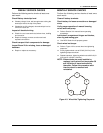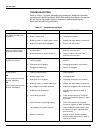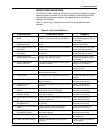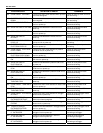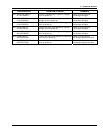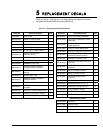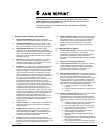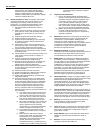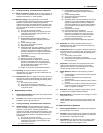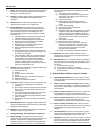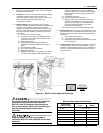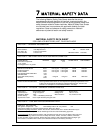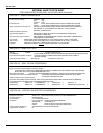
35
6 ANSI REPRINT
The following sections are reprinted from the ANSI A92.2-2001 code in
effect at the time of manufacture and govern the safe use of the Bil-Jax
Model 3522A Articulating Boom Lift.
Permission to reprint this material has been granted by the Scaffold
Industry Association.
7. Responsibilities of Dealers and Installers
7.1 General Responsibilities. Each dealer or installer as
applicable shall comply with the requirements of this section.
7.2 Vehicle Specifications. Each dealer or installer, or both,
who sells an aerial device shall inform the owner or user, or
both, of the manufacturer’s minimum vehicle specifications.
7.3 Vehicle Weight Distribution. The installer shall be
responsible for the weight distribution of the completed
mobile unit in accordance with the requirements of the aerial
device and the applicable regulations. Allowance shall be
made for the weight of readily removable tools and material
specified by the user.
7.4 Manuals. Upon delivery of the equipment to the owner or
user, the dealer or installer shall provide the manuals as
required by Paragraph 6.4 of this standard and manuals for
auxiliary equipment added by the installer.
7.5 Installations. The installer shall comply with Sections 5 and
6 of this standard relating to proper installation and shall
follow the instructions of the manufacturer. In the event the
original manufacturer no longer exists, an equivalent entity
may provide these instructions. The installer of an aerial
device shall, before the mobile unit is placed in operation,
perform stability tests in accordance with the requirements of
4.5.1 and 4.5.2, the operational and visual tests in
accordance with the requirements of 6.6.1 and 6.6.2 a, and
the appropriate electrical tests required in 5.4.3 of this
standard. The installer shall, when installing an aerial device
on a chassis which is a highway vehicle, comply with all
requirements of the Federal Motor Vehicle Safety Standards
in effect at the time of installation. Certification as a
manufacturer (alteration, intermediate or final) of a motor
vehicle under the Federal Motor Vehicle Safety Standards is
required. The travel height of a mobile unit shall be posted in
a location that is readily visible to the vehicle operator. For
insulated aerial devices, the installer shall assure
conformance to the Qualification test requirements of 5.3.2
by either obtaining certification of the test and performing a
periodic test after insulation, or by performing the
Qualification test.
7.6 Quality Assurance. The installer shall have a documented
quality assurance program which will ensure compliance
with this standard.
7.7 Welding. All welds made by the installer, whose failure
could result in motion of the platform(s) shall meet the
Structural Welding Code AWS D1.1-98 and AWS D1.2-98.
The installer shall establish applicable welding quality
assurance procedures for all weldments.
7.8 Training. The dealer or installer shall offer training or
training materials that aid owners and users in the operation,
inspection, testing and maintenance of the aerial device. The
training shall be offered initially and subsequently on
request.
7.8.1 Dealer or Installer as User. Whenever a dealer or installer
directs personnel to operate the aerial device (inspecting,
sales demonstrations, or any form of use), the dealer or
installer shall assume the responsibilities of users as
specified in Section 9 of this standard. All personnel
authorized to operate this aerial device shall have been
trained.
8. Responsibilities of Owners
8.1 General Responsibilities. Each owner shall comply with
the requirements of this section. The following
responsibilities pertain to the owner’s inspection, testing,
maintenance, modification, training and transfer of
ownership. These activities shall be performed by qualified
person(s).
8.2 Inspection and Testing Classifications.
8.2.1 Initial Inspection and Test. Prior to initial use, all new or
modified mobile units shall be inspected and tested to
ensure compliance with the provisions of this standard.
Verification by the manufacturer, the installer, or an
equivalent entity(s) meets this requirement.
8.2.2 Regular Inspection and Tests. The inspection procedure
for mobile units is divided into two classifications based upon
the intervals at which inspections and tests shall be
performed. Intervals shall be set by the owner in accordance
with the manufacturer’s recommendations. Such intervals
are dependant upon component function and exposure to
wear, deterioration and other agents which adversely affect
component life. Two classifications are designated:
(1) Frequent Inspection and Test: Daily to Monthly
intervals.
(2) Periodic Inspection and Test: One to Twelve Month
intervals.
8.2.3 Frequent Inspection and Test. Items determined to by the
owner in accordance with the manufacturer’s
recommendations for each specific aerial device shall be
inspected for defects. The following tests and inspections
shall be performed by the operator once daily, prior to first
use:
(1) Operating controls and associated mechanisms for
conditions interfering with proper operation.
(2) Visual and audible safety devices for malfunction.
(3) Hydraulic and pneumatic systems for observable
deterioration or excessive leakage.
(4) Fiberglass and other insulating components for
visible damage or contamination.
(5) Missing or illegible operational and instructional
markings.
(6) Electrical systems of/or related to the aerial device
for malfunction, signs of excessive deterioration, dirt
and moisture accumulation.
(7) Visual inspection of bolts, pins and other fasteners
for loose, deformed or missing fasteners and other



